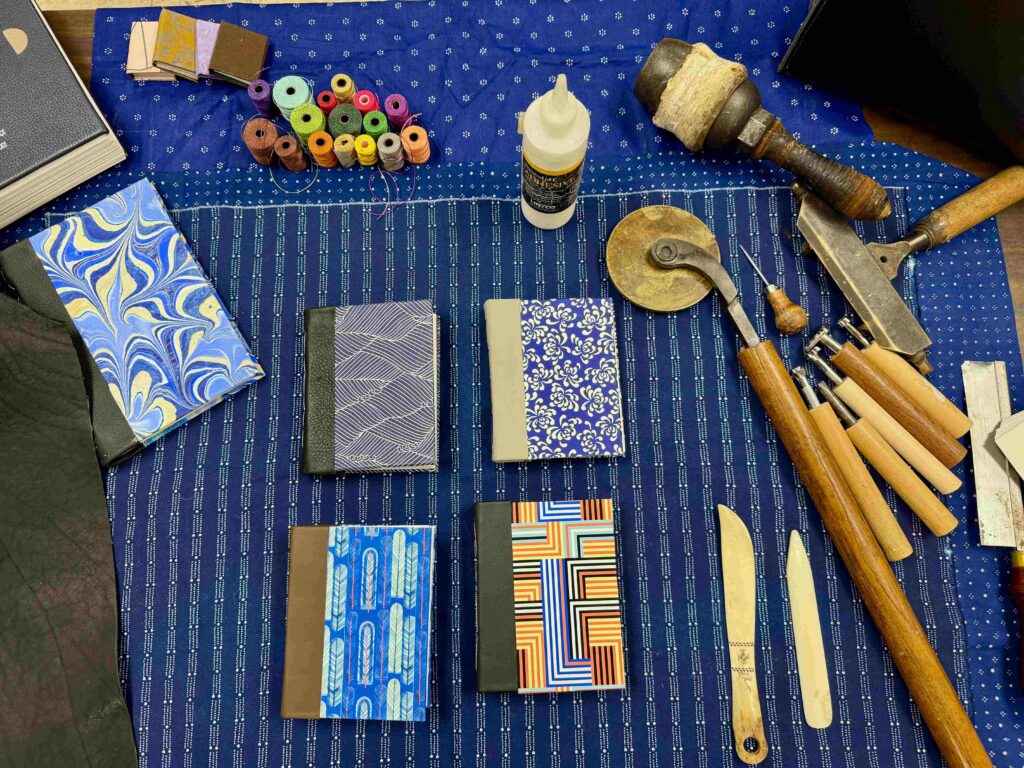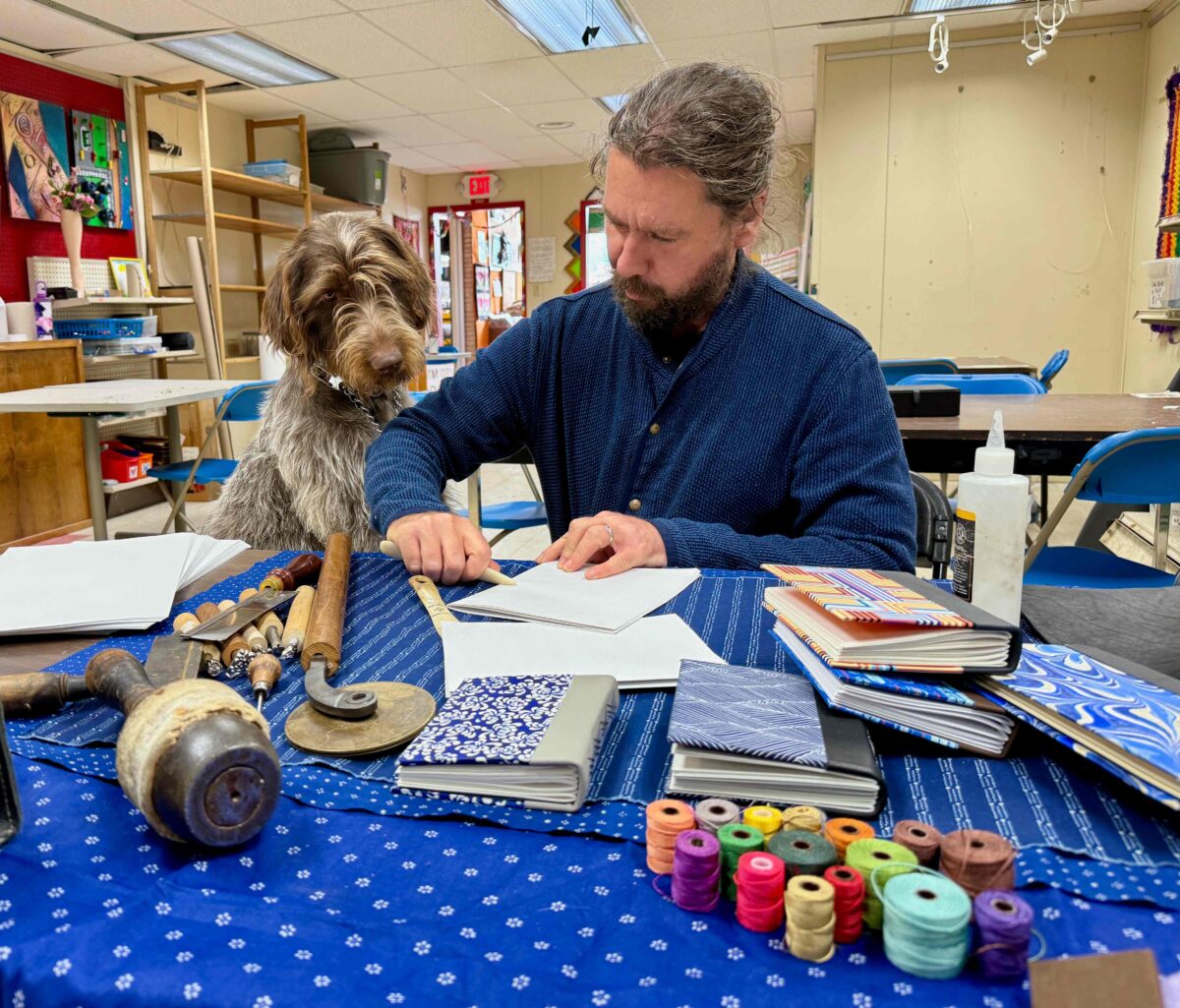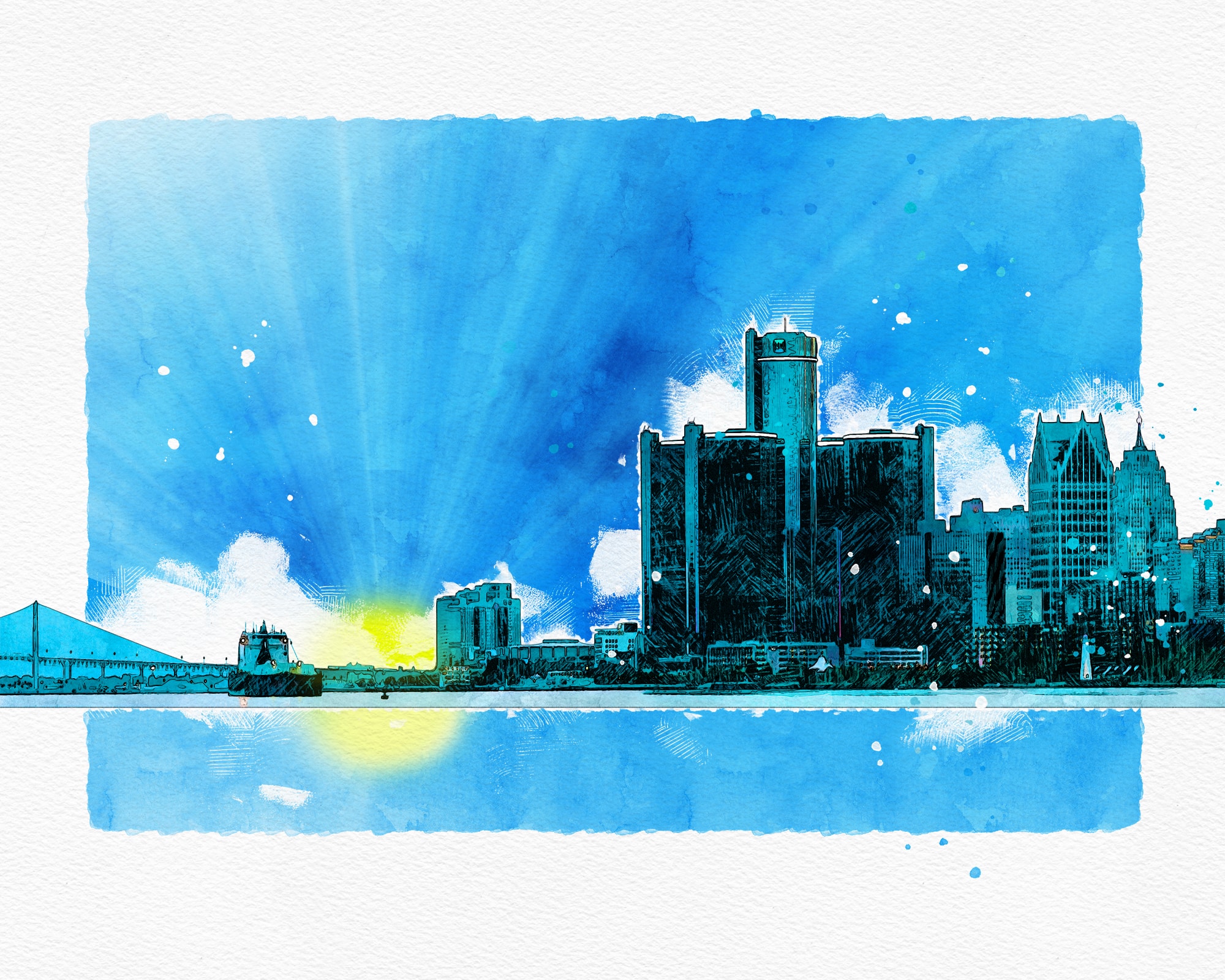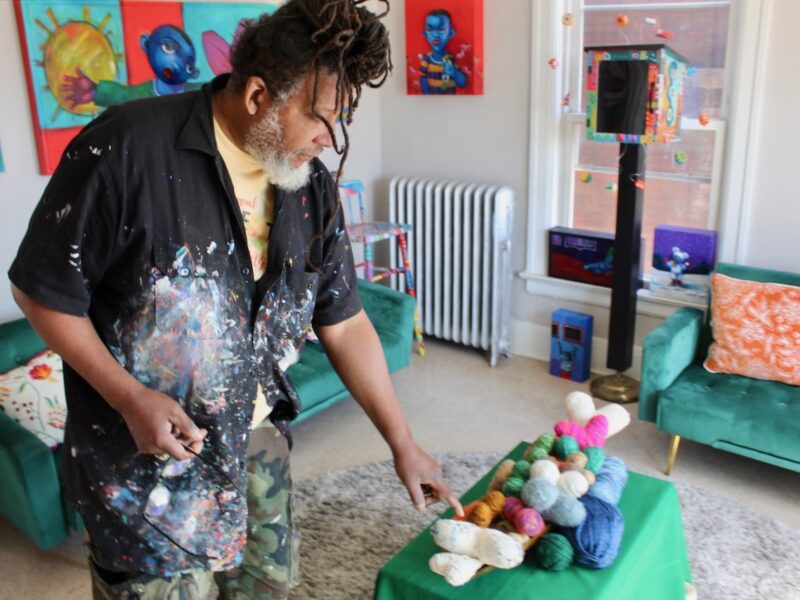Overview:
-James Griffioen swapped a law career for bookmaking.
-He sells 500 handmade journals every year at the Detroit Festival of Books.
-He volunteers weekly at Arts & Scraps, where he finds low-cost materials.
You could say it was a suit of armor that turned James Griffioen into a bookbinder.
After seeing a shiny, stoic suit at the Detroit Institute of Arts in 2011, his kids wanted their own, so Griffioen made one out of leather. Then a “completely authentic” Japanese samurai suit. Then an elaborate dragon mask.
“They dress up and we run around. It was just really magical. I loved how many things you could do with it,” he said.
As his kids grew up, he swapped costumes for leather bags. Griffioen soon realized the bags would cost a lot, given that each bag takes about seven hours to make, and the high cost of materials, he said.
“That’s not what I wanted to do with my life is make fancy bags for rich people,” he said.
He started using scraps of leather to use as the binding of books, sourcing everything from Arts & Scraps, a nonprofit community store launched in 1989 that provides reused materials and educational resources to promote sustainability and creativity.
Detroit bookmaker says ‘I’m just doing it out of love’
Since 2018, Griffioen has made roughly 10,000 leather-bound books. He set up shop a few years later, becoming an eagerly awaited presence at the Detroit Festival of Books, the largest event of its kind in Michigan showcasing used, rare, or unusual books and elbow-to-elbow browsing.
In six hours, he’ll sell nearly 500 books at the festival, he said. You won’t find his books online, as his favorite part is meeting new people in person, “like a collaborator on a project.”
“It just means so much to me to actually see somebody and hear what they’re going to use it for,” Griffioen said.
Customers return every July to buy journals for the year ahead, he said. Some even line up former journals on their shelves, showing their stories being told with his books, he said. Dungeon masters of the game Dungeons & Dragons particularly like the thick leather binding, he said.
“I hesitate to say that this is a business. I’m just doing it out of love,” he said.
MORE PLANET DETROIT REPORTING
The art of recycling: Detroiter Donald Calloway’s creative process
Detroit artist Donald Calloway transforms discarded objects like chair stools and clock parts into vibrant art pieces, filling local galleries and his Grand Boulevard studio with sustainable creativity.
Discover upcycled gems at Detroit’s Architectural Salvage Warehouse
The Architectural Salvage Warehouse of Detroit deconstructs buildings to preserve materials, aiming to reduce waste and provide second chances for people.
Craftsmanship meets storytelling at LiTO resale shop in southwest Detroit
Yvonne “Heaven” Montero, founder of LiTO in Southwest Detroit, has turned her passion for vintage fashion into a thriving resale business, emphasizing craftsmanship, storytelling and sustainability.
Arts & Scraps: The creative commons
Since 2020, Griffioen has volunteered weekly at Arts & Scraps, gladly offering his time to help the variety of customers: people from the Grosse Pointes, people from Detroit, artists, grandmothers.
“It’s the highlight of my week. Everybody’s coming in there in the spirit of being creative,” he said.
Store volunteers receive a 50% discount on already affordable prices. With his material costs low, Griffioen is able to sell his handmade, upcycled books at around the same price as a Moleskin at a Staples store: about $30, he said.
The cost of entry for a new craft is high, and discouraging to someone who wants to become a weaver, painter, or knitter, he said. Shoppers can fill up a bag of yarn for $8 at Arts & Scraps, instead of buying an individual spool for $4 at Michaels.
“But you can go to Arts & Scraps, buy enough material to start out and experiment,” he said. “It’s a wonderful opportunity for people to try things that they might never have an opportunity to try otherwise.”
Nearly half of Griffioen’s books are made from paper he’s printed himself — a scan of public domain art — or found, and the leather is reused from the auto or fashion industries. The handbag company Cuyana donates damaged bags to Arts & Scraps, and Griffioen says he tears those up to keep them out of the landfill. Each one of his materials would have gone into a landfill if not donated to Arts & Scraps, he said.
The store meticulously organizes donations, which can range from film reels, to PVC pipes, to feather boas, and only trashes those that are “absolutely unusable by anyone,” Griffioen said, like a bag of foul-smelling fabric.

Binding the old with the new
Griffioen’s binding is a variation of traditional long stitch binding, where six small sections of pages are sewn directly onto the binding, creating a cross stitch on the spine. This allows the pages to lay flat — useful for left-handed writers or artists, he said.
Griffon said he doesn’t encounter challenges working with the unconventional materials. Instead, he finds inspiration from the materials themselves, as each piece is different.
Aside from journals, he’s giving new life to texts that are out of print, in the public domain, and “impossible” to find. Griffioen said he found a PDF of the original 1917 printing of “Ulysses” by James Joyce, printed it, and bound it with his signature leather style. He then inlays the author’s face into the leather cover through a technique called leather marquetry, which involves meticulous cutting, layering and glueing of leather onto a surface.
“That’s been a fun side project too, printing real books that most people will never get to see in their lives,” he said.
Swapping law for leather
Griffioen wasn’t always in the art world. He earned his law degree from the University of Michigan in 2002 and worked in corporate law for five years in San Francisco, he said. When his daughter was born, he said it was an easy choice to walk away from “that culture” to become a stay-at-home dad.
Struggling to “fit back into capitalism,” he viewed Detroit as a stark illustration of how it failed the city. “Everywhere you looked, you saw these beautiful ruins,” he said.
“When I dip my toes back into capitalism, making books like I do, I am completely comfortable with it, because it is all sustainable,” Griffioen said.
After quitting his job as a corporate lawyer and moving to Detroit, he started the blog Sweet Juniper! to keep loved ones updated on his family’s new life. What started as readership from friends and family turned into 5,000 views a day, he said.
“It turned into levels of insanity,” Griffioen said. “It was just a cool way to wake up every morning and be excited about something creative and fun.”
On his blog he published his photography series, “Feral Houses,” reflecting on living in a city after financial distress. His photos also appeared in Harper’s Magazine, Vice, Time, and others.
“Everywhere you looked, you saw these beautiful ruins. You saw people who were surviving against all odds and doing what they could with what they had. And it was really inspirational and beautiful,” he said.
The series brought him into abandoned buildings, like the onetime Detroit Public Schools Book Depository, where the city’s public schools stored their supplies. The building has since been redeveloped as a home for Newlab, a venture platform for tech startups.
The photographs depict thousands of textbooks, piles of paper, “landscapes, mountains of ruined school supplies all over this building,” he said.
Paper from that very building, still wrapped in plastic 20 years after the building was abandoned, became some of Griffioen’s first books. He went on photographing deserted public schools and collecting discarded supplies to upcycle, he said.
Griffioen said that in our culture, we’ve been trained to think a product is faulty if it’s not perfect. He embraces imperfection, and wants the jagged edges of his journals to make people think about something made by hand as opposed to a factory, which “may feel perfect, but this thing was made with so much love,” he said.





